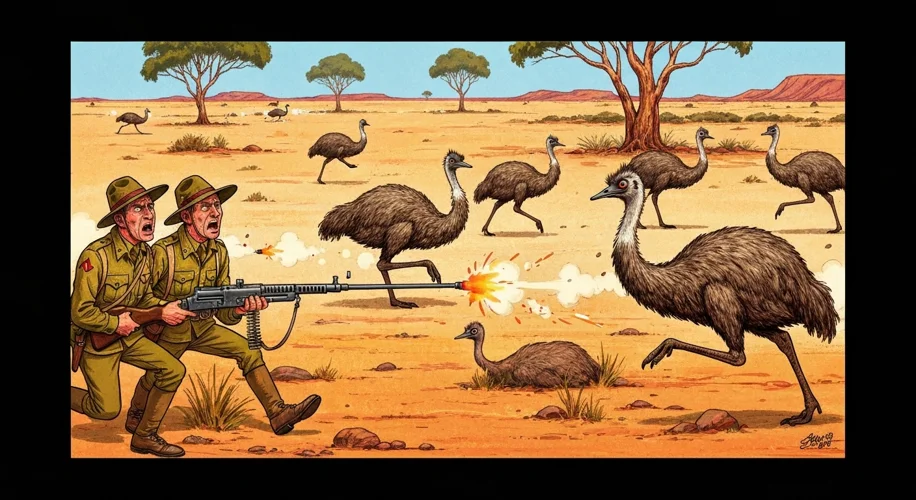Picture this scenario: the year is 1932. The Australian outback, vast and unforgiving, is facing an invasion. Not of soldiers or tanks, but of feathered adversaries – a colossal population of emus, numbering in the tens of thousands. These flightless giants, with their powerful legs and insatiable appetites, were descending upon the farmlands of Western Australia, devouring crops and tearing down fences. For the struggling farmers, it was a crisis of epic proportions.
To combat this avian menace, the Australian military was called in. Yes, you read that right. The Royal Australian Artillery, armed with two Lewis machine guns and 10,000 rounds of ammunition, were deployed to the Campion district. The objective: to conduct a large-scale cull of the emu population. Major G.P.W. Meredith, a veteran of World War I, was placed in command. Little did he know, he was about to lead one of the most bizarre military campaigns in history.

The campaign began in early November. The soldiers, accustomed to the disciplined warfare of the trenches, found themselves facing an opponent that was anything but predictable. Emus, it turned out, were remarkably elusive. They would scatter at the sound of gunfire, their long strides allowing them to cover ground with astonishing speed. The machine guns, effective against massed infantry, struggled to find their targets as the emus weaved and dodged.
On the first day, the military managed to kill only about a dozen emus. The birds seemed to have an uncanny knack for survival. When the soldiers attempted to herd them into range, the emus would split into smaller groups, making them even harder to hit. One attempt to ambush a large flock resulted in a chaotic scene where the machine gun jammed after only a few birds were felled. The emus, seemingly unfazed, continued their rampage.
Major Meredith reportedly expressed his frustration, noting that each emu seemed to possess an almost bulletproof hide and that they scattered in all directions when fired upon, making it impossible to concentrate fire.
The media had a field day with the unfolding events. Newspapers dubbed it the “Great Emu War,” and the public was amused and bewildered by the military’s struggle against its feathered foe. Cartoonists had a field day, depicting soldiers being outmaneuvered by agile emus.
After a few weeks, the operation was deemed a failure. Only a few hundred emus had been killed, a mere fraction of the vast numbers that posed a threat. The military withdrew, leaving the farmers to fend for themselves once more. The emus, it seemed, had won.
The Great Emu War of 1932 was more than just a comical footnote in Australian history; it was a stark reminder of nature’s resilience and unpredictability. It highlighted the limitations of military technology when faced with an enemy that operated outside the conventional rules of warfare. The emus, driven by instinct and survival, proved to be a formidable adversary, outmaneuvering and outlasting the modern weaponry of the Australian army.
For the farmers, the problem persisted. They continued to petition the government for assistance, and eventually, a bounty system was implemented, proving more effective than the military intervention. The story of the Great Emu War serves as a fascinating, if slightly absurd, lesson in humility, adaptation, and the enduring power of the wild.

